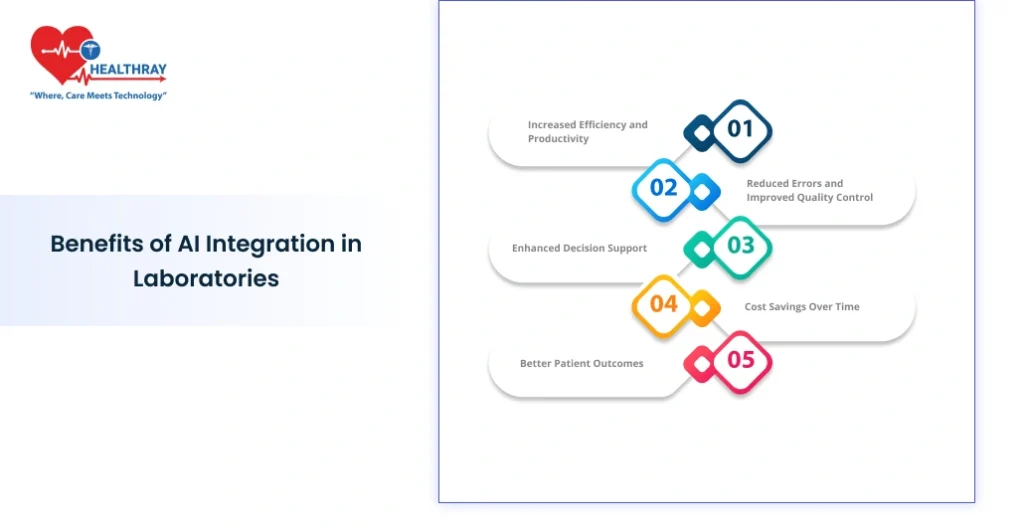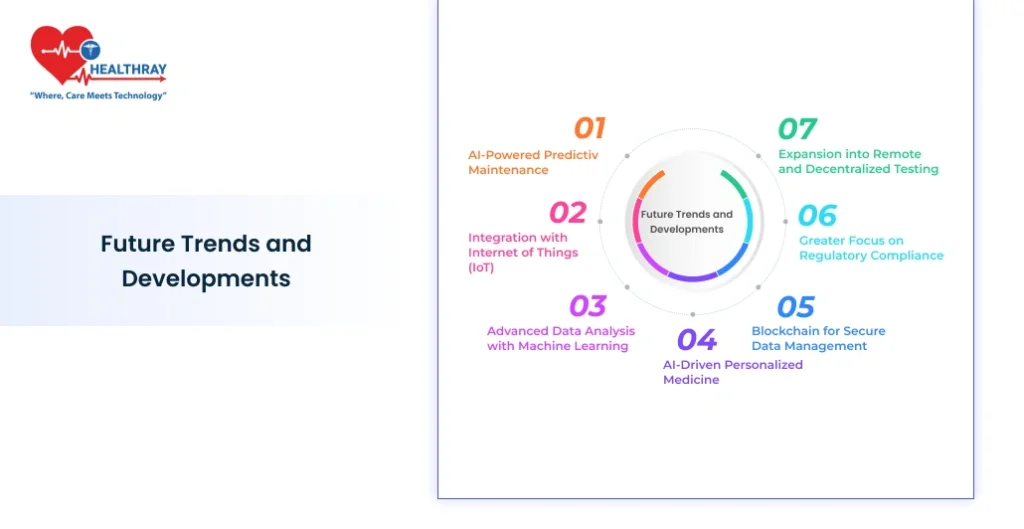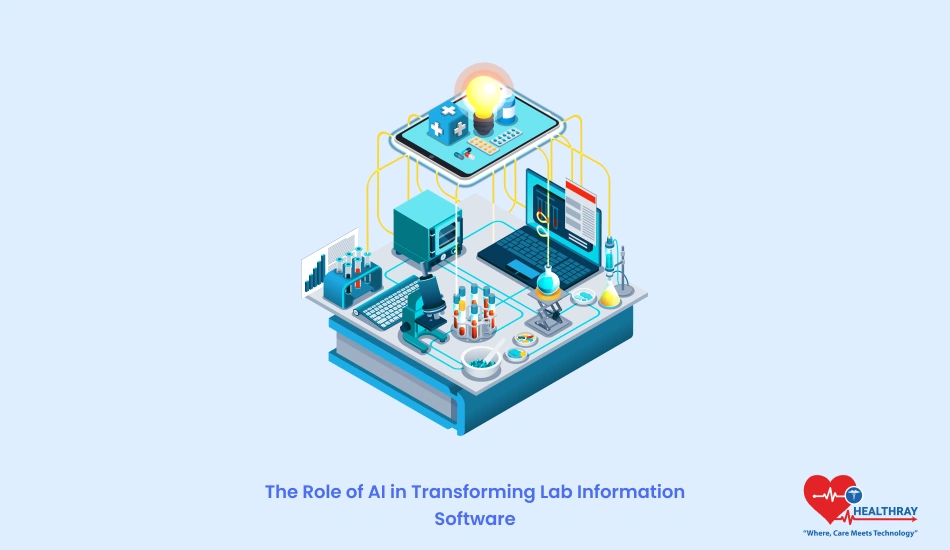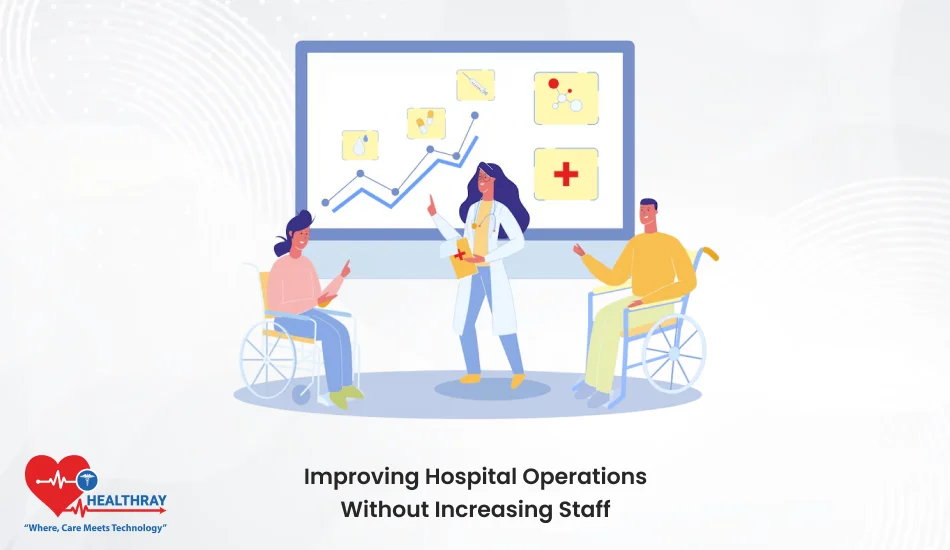Artificial Intelligence (AI) has reshaped industries worldwide, and healthcare is no exception. Laboratories, often the backbone of medical diagnostics, are now integrating AI to revolutionize how they handle data, manage workflows, and deliver results.
But why is AI so impactful in laboratories? For one, labs process massive amounts of data daily. From patient records to test results, every piece of information must be accurate and accessible. AI doesn’t just automate these processes; it brings a level of precision and speed that traditional systems can’t match.
In this blog, we’ll dive into how AI is transforming the Laboratory Information Management System, explore the challenges laboratories face, and highlight the future of AI-driven advancements in this critical field. Stick around to learn how labs are embracing a smarter way to work.
Understanding Laboratory Information Systems (LIS)

Laboratory Information Systems (LIS) are the digital backbones of modern labs. They store, manage, and analyze a wide range of lab data, from patient demographics to detailed test results. These systems ensure that workflows remain streamlined and that healthcare professionals have the insights they need at their fingertips.
Current Challenges in Laboratories
Despite their importance, many laboratories face significant hurdles with their existing systems:
- Data Overload: Modern labs generate vast amounts of data. Traditional systems struggle to process and organize this information efficiently.
- Manual Errors: Manual data entry and processing introduce the risk of mistakes, which can have serious consequences in healthcare settings.
- Integration Issues: Many LIS lack the ability to integrate with other healthcare technologies, leading to fragmented workflows and inefficient communication.
- Scalability Problems: As laboratories grow, their systems often fail to keep up, creating bottlenecks in operations.
These challenges make it clear that traditional LIS need an upgrade. That’s where AI steps in, offering not just an improvement but a transformation.
The Role of AI in Transforming Laboratory Information Systems

AI has emerged as a game-changer for laboratories, addressing long-standing inefficiencies and bringing advanced capabilities to Laboratory Information Systems (LIS). From automating routine tasks to enhancing diagnostic accuracy, AI is transforming how labs operate and deliver results.
Enhancing Data Management and Analysis
Laboratories handle an immense volume of data daily. AI-powered systems can:
- Streamline Data Entry: Automate data collection from instruments, reducing manual errors.
- Analyze Complex Data Sets: Use algorithms to detect patterns and trends that might be missed by traditional methods.
- Generate Predictive Insights: Provide forecasts based on historical data, helping labs anticipate future workloads or potential errors.
Improving Diagnostic Accuracy
AI-driven LIS can process data at incredible speeds, enabling:
- Faster Results: Deliver diagnostic results in record time, aiding quicker treatment decisions.
- Error Detection: Spot anomalies or inconsistencies in data, flagging potential errors before they escalate.
- Support for Personalized Medicine: Analyze patient data to recommend tailored treatments based on genetic or historical information.
Streamlining Workflows and Automation
AI eliminates many of the manual bottlenecks in lab operations by:
- Automating Routine Tasks: Handle repetitive processes like inventory management and report generation.
- Optimizing Scheduling: Allocate resources efficiently, ensuring instruments and staff are used effectively.
- Reducing Turnaround Times: Ensure faster sample processing and report delivery.
Supporting Personalized Medicine
One of the most significant advancements AI brings to LIS is its role in personalized medicine. By analyzing patient-specific data, AI helps:
- Identify the best diagnostic tests for an individual.
- Recommend targeted therapies based on genetic markers.
- Monitor treatment progress in real time, ensuring better outcomes.
AI doesn’t just improve current processes—it redefines what’s possible for laboratory operations.
Benefits of AI Integration in Laboratories

The integration of AI into Laboratory Information Systems (LIS) is not just about modernizing processes. It’s about unlocking new efficiencies, improving accuracy, and creating opportunities for better patient outcomes. Here’s a closer look at the key benefits AI brings to laboratories.
Increased Efficiency and Productivity
AI dramatically reduces the time spent on routine tasks. By automating data entry, sample tracking, and report generation, lab staff can focus on higher-value activities. This leads to:
- Faster processing of test samples.
- Reduced operational bottlenecks.
- Streamlined workflows from sample collection to final reporting.
Reduced Errors and Improved Quality Control
Manual errors in laboratories can have significant repercussions. AI minimizes these risks by:
- Error Detection: Identifying discrepancies in data, ensuring accurate results.
- Quality Checks: Continuously monitoring equipment and processes to maintain high standards.
- Standardized Procedures: Automating repetitive tasks, reducing variability across tests.
Enhanced Decision Support
AI-driven systems provide actionable insights by analyzing vast datasets in real time. This helps:
- Pathologists and Lab Managers: Make informed decisions quickly.
- Healthcare Professionals: Access precise diagnostic information to guide treatment plans.
- Owners and Administrators: Optimize resource allocation and financial planning.
Cost Savings Over Time
While the initial investment in AI integration may seem high, the long-term savings are significant. Labs can:
- Lower labor costs by automating time-intensive tasks.
- Reduce waste by optimizing inventory management.
- Minimize costly diagnostic errors that can lead to retesting or legal liabilities.
Better Patient Outcomes
Ultimately, the biggest beneficiaries of AI in labs are patients. Faster diagnostics, fewer errors, and personalized insights contribute to:
- Early disease detection and intervention.
- Tailored treatment plans based on individual data.
- Improved overall healthcare delivery.
AI doesn’t just enhance how labs operate—it creates a ripple effect that benefits the entire healthcare ecosystem.
Challenges and Considerations
While the benefits of integrating AI into Laboratory Information Systems (LIS) are undeniable, the journey is not without its challenges. Labs need to address these issues to ensure successful implementation and long-term benefits.
Implementation Hurdles
Transitioning to an AI-driven LIS can be daunting. Common challenges include:
- Cost of Integration: AI solutions often require significant upfront investment in hardware, software, and training.
- System Compatibility: Existing Lab Information Systems may not be easily compatible with new AI tools, necessitating upgrades or replacements.
- Time-Intensive Process: Implementing and fine-tuning AI systems can disrupt daily operations initially.
Data Privacy and Security Concerns
AI systems rely on large datasets to function effectively, which can raise concerns about:
- Patient Privacy: Ensuring compliance with regulations like GDPR, HIPAA, and other data protection laws.
- Data Breaches: Safeguarding sensitive patient and lab information from cyberattacks.
- Ownership Issues: Determining who owns the data and how it can be used ethically.
Resistance to Change
Adopting AI requires a cultural shift within the organization, which may face:
- Staff Reluctance: Employees may fear that AI will replace their jobs, leading to resistance during implementation.
- Training Requirements: Labs must invest in training staff to use new systems effectively.
- Leadership Buy-In: Convincing decision-makers of the long-term value of AI is crucial for securing funding and support.
Ongoing Maintenance and Updates
AI systems require regular updates to stay effective, which can pose:
- Maintenance Costs: Ensuring that systems remain functional and up-to-date.
- Algorithm Bias: Addressing biases in AI algorithms to prevent inaccurate or unfair outcomes.
- Monitoring Performance: Continuously evaluating AI outputs to ensure reliability and accuracy.
Overcoming these challenges requires careful planning, investment in staff training, and a strong commitment to change management. With the right approach, labs can navigate these obstacles and fully realize the transformative potential of AI.
Case Studies and Real-World Applications
To understand the tangible impact of AI on Laboratory Information Systems (LIS), let’s explore real-world examples where AI has successfully transformed lab operations. These case studies highlight the practical benefits and lessons learned from implementing AI-driven solutions.
Case Study 1: AI for Streamlining Diagnostic Workflows
A leading pathology lab faced significant delays in processing biopsy samples due to high workloads and manual inefficiencies. By integrating an AI-driven LIS:
- Outcome: Turnaround times for biopsy reports reduced by 40%.
- Key Features Used: Automated image analysis for faster diagnostics and AI-powered prioritization of urgent cases.
- Impact: Pathologists were able to focus more on complex cases while routine tasks were automated, enhancing overall productivity.
Case Study 2: Improving Quality Control in a Research Lab
A pharmaceutical research lab struggled with maintaining consistent quality in large-scale testing. After implementing AI tools:
- Outcome: Reduced errors in quality checks by 25%.
- Key Features Used: Predictive analytics for equipment maintenance and automated flagging of outlier results.
- Impact: The lab achieved regulatory compliance more efficiently and decreased downtime due to equipment failure.
Case Study 3: Personalizing Medicine in a Diagnostic Lab
A healthcare diagnostics provider aimed to deliver tailored treatment recommendations using patient-specific data. With an AI-enhanced LIS:
- Outcome: Identified precise treatment paths for over 10,000 patients annually.
- Key Features Used: Machine learning models analyzing genetic and clinical data.
- Impact: Enabled personalized healthcare, improving treatment outcomes for complex diseases like cancer and rare genetic disorders.
Key Lessons Learned from These Applications
- Gradual Implementation Works Best: Labs found success by starting with one AI feature, then scaling as staff became comfortable.
- Training is Critical: Comprehensive staff training ensures smooth adoption of AI tools.
- Collaboration Matters: AI implementation works better when IT teams, lab managers, and healthcare professionals collaborate.
These examples show how AI can address specific challenges, optimize workflows, and improve outcomes in labs. With careful planning and execution, similar transformations can be achieved across the industry.
Future Trends and Developments

AI in Laboratory Information Systems (LIS) is just the beginning of a larger transformation in how labs operate. As technology continues to evolve, several emerging trends and developments promise to reshape the laboratory landscape even further.
AI-Powered Predictive Maintenance
Future LIS will likely include advanced predictive maintenance tools that monitor lab equipment in real-time. These systems will:
- Predict potential equipment failures before they occur.
- Schedule maintenance automatically to reduce downtime.
- Extend the lifespan of costly lab instruments.
Integration with Internet of Things (IoT)
IoT-enabled devices are becoming a key component in laboratories. When paired with AI, these devices can:
- Enable seamless data sharing across lab equipment.
- Monitor environmental factors like temperature and humidity to ensure sample integrity.
- Automate inventory management by tracking reagent levels and usage patterns.
Advanced Data Analysis with Machine Learning
AI will expand its role in data analysis through:
- Deep learning algorithms capable of uncovering patterns in complex datasets.
- Real-time analysis for faster decision-making.
- Improved accuracy in detecting rare diseases through multi-modal data integration (e.g., combining imaging, genetic, and clinical data).
AI-Driven Personalized Medicine
AI’s role in personalized medicine will deepen as LIS begin to:
- Analyze genomic data to create individualized treatment plans.
- Predict disease progression using patient-specific data.
- Provide clinicians with evidence-based insights for tailored healthcare delivery.
Blockchain for Secure Data Management
As labs handle increasingly sensitive data, blockchain technology will complement AI by:
- Ensuring secure and transparent data storage.
- Protecting patient information with tamper-proof records.
- Enabling easier data sharing across institutions while maintaining privacy.
Greater Focus on Regulatory Compliance
Regulatory bodies will likely introduce new standards for AI in laboratories. Future LIS will need to:
- Maintain compliance with evolving regulations on data usage and security.
- Provide detailed audit trails for AI-driven decisions.
- Demonstrate the reliability and fairness of AI algorithms.
Expansion into Remote and Decentralized Testing
AI-driven LIS will support decentralized lab models by:
- Enabling remote testing capabilities.
- Facilitating real-time data sharing between central labs and satellite locations.
- Supporting telemedicine initiatives by integrating seamlessly with virtual care platforms.
The future of AI in LIS is bright, with new innovations paving the way for smarter, more efficient laboratories. Labs that stay ahead of these trends will be better positioned to deliver faster, more accurate results and improve patient care.
Conclusion
The integration of AI into Laboratory Information Systems (LIS) marks a significant leap forward for laboratories, pathologists, and healthcare providers. By automating workflows, enhancing data analysis, and enabling personalized medicine, AI is not just improving efficiency—it’s redefining how labs operate.While challenges such as implementation costs, data security, and resistance to change remain, the potential benefits far outweigh the hurdles. AI-driven Hospital Management Systems help laboratories manage increasing workloads, reduce errors, and deliver faster, more accurate diagnostics, ultimately leading to better patient outcomes.





